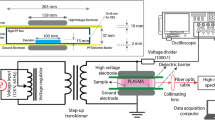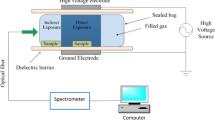Abstract
Zearalenone (ZEA) is a mycotoxin that contaminates cereals and grains. Atmospheric cold plasma (ACP) is a novel non-thermal technology that has the potential to degrade mycotoxins. This study evaluated the potential of ACP and the influence of some of the important product and process factors on the degradation of ZEA. The efficacy of 30 s dielectric barrier discharge (DBD) ACP treatment to degrade ZEA in solution and dry condition was 100% and 66.8%, respectively. The ZEA degradation was influenced by the product substrate as the ZEA degradation rates after 3 min DBD-ACP treatment on canola grain, canola meal, and barley grains were 91.6, 83.2, and 64.8%, respectively. Treatment using light pulses (395 nm wavelength) emitted from light-emitting diodes (LED) for 30 min and thermal treatment at 80 °C for 25 min did not exhibit any synergistic effect with ACP on ZEA degradation. The ZEA degradation rates were not significantly different (p > 0.05) when air and 100% N2 were used to generate the ACP by DBD. Treatment by ACP jet using 85% Ar + 15% O2 resulted in the highest degradation of ZEA compared to other gas mixtures used. The results of ZEA degradation using ACP jet, DBD-ACP, and different gas mixtures indicated that there could be contributions from factors other than the measured reactive species, such as UV light and high-energy electrons on ZEA degradation.



Similar content being viewed by others
Data availability
Not applicable.
References
AACC 44–19.01. AACC approved methods of analysis. 11th Ed. Method 44–19.01. Moisture—Air-Oven Method, Drying at 135°C. November 3, 1999. Cereals & Grains Association, St. Paul, MN, U.S.A. https://doi.org/10.1094/AACCIntMethod-44-19.01
Chain, E. Panel o. C. i. t. F., Knutsen, H.-K., Alexander, J., Barregård, L., Bignami, M., Brüschweiler, B., Ceccatelli, S., Cottrill, B., Dinovi, M., Edler, L., Grasl-Kraupp, B., Hogstrand, C., Hoogenboom, L., Nebbia, C. S., Petersen, A., Rose, M., Roudot, A.-C., Schwerdtle, T., Vleminckx, C., Vollmer, G., Wallace, H., Dall'Asta, C., Dänicke, S., Eriksen, G.-S., Altieri, A., Roldán-Torres, R., & Oswald, I. P. (2017). Risks for animal health related to the presence of zearalenone and its modified forms in feed. EFSA Journal, 15(7), e04851. https://doi.org/10.2903/j.efsa.2017.4851
Chen, D., Chen, P., Cheng, Y., Peng, P., Liu, J., Ma, Y., Liu, Y., & Ruan, R. (2018). Deoxynivalenol decontamination in raw and germinating barley treated by plasma-activated water and intense pulsed light [article in press]. Food and Bioprocess Technology. https://doi.org/10.1007/s11947-018-2206-2
Chigbo, E. O. J. (2016). Selected physical properties of soybean in relation to storage design. International Journal of Engineering Research and Applications, 6, 71–75.
Chilaka, C. A., De Boevre, M., Atanda, O. O., & De Saeger, S. (2018). Stability of fumonisin B1, deoxynivalenol, zearalenone, and T-2 toxin during processing of traditional Nigerian beer and spices. Mycotoxin Research, 34(4), 229–239. https://doi.org/10.1007/s12550-018-0318-1
Cullen, P. J., Misra, N., Han, L., Bourke, P., Keener, K., O’Donnell, C., Moiseev, T., Mosnier, J. P., & Milosavljević, V. (2014). Inducing a dielectric barrier discharge plasma within a package. IEEE Transactions on Plasma Science, 42(10), 2368–2369.
FAO. (2003). Mycotoxin regulations in 2003 and current developments. Retrieved April 27, 2021 from http://www.fao.org/3/y5499e/y5499e07.htm
Feizollahi, E., Arshad, M., Yadav, B., Ullah, A., & Roopesh, M. S. (2020a). 2020/08/07). Degradation of Deoxynivalenol by Atmospheric-Pressure Cold Plasma and Sequential Treatments with Heat and UV Light. Food Engineering Reviews. https://doi.org/10.1007/s12393-020-09241-0
Feizollahi, E., Iqdiam, B., Vasanthan, T., Thilakarathna, M. S., & Roopesh, M. (2020b). Effects of atmospheric-pressure cold plasma treatment on deoxynivalenol degradation, quality parameters, and germination of barley grains. Applied Sciences, 10(10), 3530.
Feizollahi, E., Misra, N. N., & Roopesh, M. S. (2021). Factors influencing the antimicrobial efficacy of Dielectric Barrier Discharge (DBD) Atmospheric Cold Plasma (ACP) in food processing applications. Critical Reviews in Food Science and Nutrition, 61(4), 666–689. https://doi.org/10.1080/10408398.2020.1743967
Ferreira, C. D., Lang, G. H., Lindemann, I. d. S., Timm, N. d. S., Hoffmann, J. F., Ziegler, V., & de Oliveira, M. (2021). Postharvest UV-C irradiation for fungal control and reduction of mycotoxins in brown, black, and red rice during long-term storage. Food Chemistry, 339, 127810. https://doi.org/10.1016/j.foodchem.2020.127810
Guerre, P. (2016). Worldwide mycotoxins exposure in pig and poultry feed formulations. Toxins, 8(12), 350. https://doi.org/10.3390/toxins8120350
Han, L., Boehm, D., Amias, E., Milosavljević, V., Cullen, P. J., & Bourke, P. (2016). Atmospheric cold plasma interactions with modified atmosphere packaging inducer gases for safe food preservation. Innovative Food Science & Emerging Technologies, 38, 384–392. https://doi.org/10.1016/j.ifset.2016.09.026
Jauković, M., Stanišić, N., Nikodijević, B., & Krnjaja, V. (2014). Effects of temperature and time on deoxynivalenol (DON) and zearalenone (ZON) content in corn. Zbornik Matice srpske za prirodne nauke(126), 25–34.
Jo, A., Joh, H. M., Chung, J., & Chung, T. (2020). Cell viability and measurement of reactive species in gas-and liquid-phase exposed by a microwave-excited atmospheric pressure argon plasma jet. Current Applied Physics, 20(4), 562–571.
Krstović, S., Krulj, J., Jakšić, S., Bočarov-Stančić, A., & Jajić, I. (2020). Ozone as decontaminating agent for ground corn containing deoxynivalenol, zearalenone, and ochratoxin A [Article]. Cereal Chemistry. https://doi.org/10.1002/cche.10289
Li, M., Yan, Y., Jin, Q., Liu, M., Zhu, B., Wang, L., Li, T., Tang, X.-J., & Zhu, Y.-M. (2018). Experimental study on ozone generation from oxygen in double surface dielectric barrier discharge. Vacuum, 157, 249–258.
Machala, Z., Janda, M., Hensel, K., Jedlovský, I., Leštinská, L., Foltin, V., Martišovitš, V., & Morvova, M. (2007). Emission spectroscopy of atmospheric pressure plasmas for bio-medical and environmental applications. Journal of Molecular Spectroscopy, 243(2), 194–201.
McClurkin-Moore, J. D., Ileleji, K. E., & Keener, K. M. (2017). The effect of high-voltage atmospheric cold plasma treatment on the shelf-life of distillers wet grains [article]. Food and Bioprocess Technology, 10(8), 1431–1440. https://doi.org/10.1007/s11947-017-1903-6
Misra, N., Yadav, B., Roopesh, M., & Jo, C. (2019). Cold plasma for effective fungal and mycotoxin control in foods: Mechanisms, inactivation effects, and applications. Comprehensive Reviews in Food Science and Food Safety, 18(1), 106–120. https://doi.org/10.1111/1541-4337.12398
Murata, H., Mitsumatsu, M., & Shimada, N. (2008). Reduction of feed-contaminating mycotoxins by ultraviolet irradiation: an in vitro study. Food Additives & Contaminants: Part A, 25(9), 1107–1110. https://doi.org/10.1080/02652030802057343
Ouellette, R. J., & Rawn, J. D. (2015). 3 - Introduction to organic reaction mechanisms. In R. J. Ouellette & J. D. Rawn (Eds.), Organic Chemistry Study Guide (pp. 31–46). Elsevier. https://doi.org/10.1016/B978-0-12-801889-7.00003-0
Parigger, C. G., Guan, G., & Hornkohl, J. O. (2003). Measurement and analysis of OH emission spectra following laser-induced optical breakdown in air. Applied Optics, 42(30), 5986–5991.
Pekárek, S. (2003). Non-thermal plasma ozone generation. Acta Polytechnica, 43(6).
Popović, V., Fairbanks, N., Pierscianowski, J., Biancaniello, M., Zhou, T., & Koutchma, T. (2018, 2018/08/01). Feasibility of 3D UV-C treatment to reduce fungal growth and mycotoxin loads on maize and wheat kernels. Mycotoxin Research, 34(3), 211–221. https://doi.org/10.1007/s12550-018-0316-3
Rai, A., Das, M., Tripathi, A. (2019) Occurrence and toxicity of a fusarium mycotoxin, zearalenone. Critical Reviews in Food Science and Nutrition 1–20 https://doi.org/10.1080/10408398.2019.1655388
Ren, C., Xiao, J., Wang, S., Jiang, W., Zhang, Y., & Liu, Z. (2017). Effect of peanut components on the degradation of aflatoxin B_1 treated by atmospheric pressure plasma. Sci. Technol. Cereal. Oils Foods, 2, 7.
Ropejko, K., & Twarużek, M. (2021). Zearalenone and its metabolites-general overview, occurrence, and toxicity. Toxins (Basel), 13(1). https://doi.org/10.3390/toxins13010035
Sakudo, A., Toyokawa, Y., Misawa, T., & Imanishi, Y. (2017). Degradation and detoxification of aflatoxin B1 using nitrogen gas plasma generated by a static induction thyristor as a pulsed power supply. Food Control, 73, 619–626.
Santos Alexandre, A. P., Vela-Paredes, R. S., Santos, A. S., Costa, N. S., Canniatti-Brazaca, S. G., Calori-Domingues, M. A., & Augusto, P. E. D. (2018). Ozone treatment to reduce deoxynivalenol (DON) and zearalenone (ZEN) contamination in wheat bran and its impact on nutritional quality [Article]. Food Additives and Contaminants - Part A Chemistry, Analysis, Control, Exposure and Risk Assessment, 35(6), 1189–1199. https://doi.org/10.1080/19440049.2018.1432899
Sarangapani, C., Misra, N., Milosavljevic, V., Bourke, P., O’Regan, F., & Cullen, P. (2016). Pesticide degradation in water using atmospheric air cold plasma. Journal of Water Process Engineering, 9, 225–232.
Sebaei, A. S., Sobhy, H. M., Fouzy, A. S. M., & Hussain, O. A. (2020). Occurrence of zearalenone in grains and its reduction by gamma radiation [Article]. International Journal of Environmental Analytical Chemistry. https://doi.org/10.1080/03067319.2020.1756282
Shi, H., Ileleji, K., Stroshine, R. L., Keener, K., & Jensen, J. L. (2017). Reduction of aflatoxin in corn by high voltage atmospheric cold plasma [Article]. Food and Bioprocess Technology, 10(6), 1042–1052. https://doi.org/10.1007/s11947-017-1873-8
Siciliano, I., Spadaro, D., Prelle, A., Vallauri, D., Cavallero, M. C., Garibaldi, A., & Gullino, M. L. (2016). Use of cold atmospheric plasma to detoxify hazelnuts from aflatoxins [Article]. Toxins, 8(5), Article 125. https://doi.org/10.3390/toxins8050125
Soler-Arango, J., Brelles-Mariño, G., Rodero, A., & Garcia, M. C. (2018). Characterization of an air-based coaxial dielectric barrier discharge plasma source for biofilm eradication. Plasma Chemistry and Plasma Processing, 38(3), 535–556. https://doi.org/10.1007/s11090-018-9877-3
Stanley, J., Patras, A., Pendyala, B., Vergne, M. J., & Bansode, R. R. (2020). Performance of a UV-A LED system for degradation of aflatoxins B1 and M1 in pure water: kinetics and cytotoxicity study. Scientific Reports, 10(1), 13473. https://doi.org/10.1038/s41598-020-70370-x
Walsh, J. L., Liu, D.-X., Iza, F., Rong, M.-Z., & Kong, M. G. (2010). Contrasting characteristics of sub-microsecond pulsed atmospheric air and atmospheric pressure helium–oxygen glow discharges. Journal of Physics D: Applied Physics, 43(3), 032001.
Whitehead, J. C. (2016). Chapter 3 - The Chemistry of Cold Plasma. In N. N. Misra, O. Schlüter, & P. J. Cullen (Eds.), Cold plasma in food and agriculture (pp. 53–81). Academic Press. https://doi.org/10.1016/B978-0-12-801365-6.00003-2
Xu, L., Sun, X., Wan, X., Li, H., Yan, F., Han, R., Li, H., Li, Z., Tian, Y., Liu, X., Kang, X., & Wang, Y. (2020). Identification of a Bacillus amyloliquefaciens H6 Thioesterase Involved in Zearalenone Detoxification by Transcriptomic Analysis [Article]. Journal of Agricultural and Food Chemistry, 68(37), 10071–10080. https://doi.org/10.1021/acs.jafc.0c03954
Yadav, B., Spinelli, A. C., Govindan, B. N., Tsui, Y. Y., McMullen, L. M., & Roopesh, M. S. (2019). Cold plasma treatment of ready-to-eat ham: Influence of process conditions and storage on inactivation of Listeria innocua. Food Research International, 123, 276–285. https://doi.org/10.1016/j.foodres.2019.04.065
Yang, K., Li, K., Pan, L., Luo, X., Xing, J., Wang, J., Wang, L., Wang, R., Zhai, Y., & Chen, Z. (2020). Effect of ozone and electron beam irradiation on degradation of zearalenone and ochratoxin A. Toxins, 12(2), 138.
Yu, J., Zhang, W., Wu, X., Wu, L., Tao, J., & Huang, K. (2021). The influence of gas humidity on the discharge properties of a microwave atmospheric-pressure coaxial plasma jet. AIP Advances, 11(2), 025131.
Yumbe-Guevara, B. E., Imoto, T., & Yoshizawa, T. (2003). Effects of heating procedures on deoxynivalenol, nivalenol and zearalenone levels in naturally contaminated barley and wheat. Food Additives & Contaminants, 20(12), 1132–1140. https://doi.org/10.1080/02652030310001620432
Zheng, T., Liu, Y., Wang, J., & Pei, Y. (2020). Degradation of Mycotoxins in Corn Germ and Crude Corn Oil by Steaming Corn Germ with Dilute Alkali [Article]. Shipin Kexue/food Science, 41(13), 8–13. https://doi.org/10.7506/spkx1002-6630-20190605-049
Funding
This study was funded by the Alberta Agriculture and Forestry, Alberta Canola Producers Commission, and Natural Sciences and Engineering Research Council (grant nos. ACPC103MD2018, 2018F180R, RGPIN-2017–05051, CRDPJ532306).
Author information
Authors and Affiliations
Contributions
E.F: conceptualization, methodology, software, validation, investigation, writing—original draft, review and editing. M.S.R: conceptualization, methodology, investigation, review and editing, supervision, funding acquisition.
Corresponding author
Ethics declarations
Ethics Approval
Not applicable.
Consent to Participate
Not applicable.
Consent for Publication
Not applicable.
Conflict of Interest
The authors declare no competing interests.
Additional information
Publisher’s Note
Springer Nature remains neutral with regard to jurisdictional claims in published maps and institutional affiliations.
Supplementary Information
Below is the link to the electronic supplementary material.
Rights and permissions
About this article
Cite this article
Feizollahi, E., Roopesh, M.S. Degradation of Zearalenone by Atmospheric Cold Plasma: Effect of Selected Process and Product Factors. Food Bioprocess Technol 14, 2107–2119 (2021). https://doi.org/10.1007/s11947-021-02692-1
Received:
Accepted:
Published:
Issue Date:
DOI: https://doi.org/10.1007/s11947-021-02692-1




